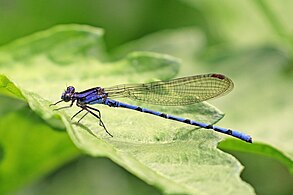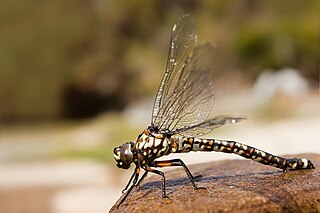
Aeshnidae, also called aeshnids, hawkers, or darners, is a family of dragonflies, found nearly worldwide, with more than 50 genera and over 450 species.

The chasers, darters, skimmers and perchers and their relatives form the Libellulidae, the largest family of dragonflies. It is sometimes considered to contain the Corduliidae as the subfamily Corduliinae and the Macromiidae as the subfamily Macromiinae. Even if these are excluded, there remains a family of over 1000 species. With nearly worldwide distribution, these are almost certainly the most often seen of all dragonflies.

Coenagrionidae is a family of damselflies, also known as pond damselfies, in the order Odonata and the suborder Zygoptera. The Zygoptera are the damselflies, which although less known than the dragonflies, are no less common. More than 1,300 species are in this family, making it the largest damselfly family. The family Coenagrionidae has six subfamilies: Agriocnemidinae, Argiinae, Coenagrioninae, Ischnurinae, Leptobasinae, and Pseudagrioninae.

Rhionaeschna is the scientific name of a genus of dragonflies from the family Aeshnidae. They are also known as blue-eyed darners.

Sympetrum is a genus of small to medium-sized skimmer dragonflies, known as darters in the UK and as meadowhawks in North America. The more than 50 species predominantly live in the temperate zone of the Northern Hemisphere; 15 species are native to North America. No Sympetrum species is native to Australia.

The Platycnemididae are a family of damselflies. They are known commonly as white-legged damselflies. There are over 400 species native to the Old World. The family is divided into several subfamilies.
Epigomphus is a genus of dragonflies in the family Gomphidae. They are commonly known as knobtails.

Erythrodiplax is a large Neotropical genus of dragonflies in the family Libellulidae. These small to medium-sized skimmers are commonly known as dragonlets.

Gynacantha is a genus of dragonflies in the family Aeshnidae. The females have two prominent spines under the last abdominal segment. This gives the genus name and the common name two-spined darners; they are also known as duskhawkers.
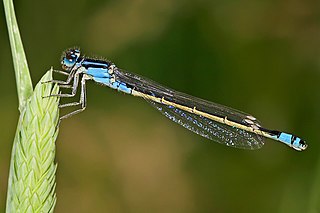
Ischnura is a genus of damselflies known as forktails in the family Coenagrionidae. Forktails are distributed worldwide, including various oceanic islands. The males have a forked projection at the tip of the abdomen which gives the group their common name.

Neoneura is a genus of damselfly in the threadtail family Coenagrionidae. They are found in the Neotropics, from Cuba and Texas to Argentina.

Progomphus is a genus of medium-sized dragonflies in the family Gomphidae. They are found in the Americas and are largely tropical. They are one of the few Gomphids with coloured wings.
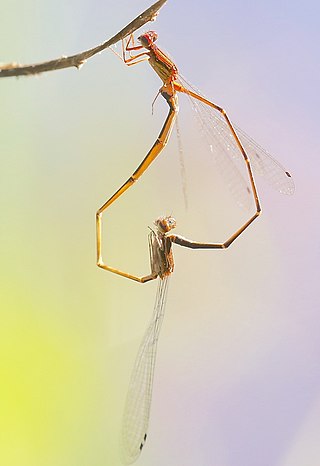
Protoneura is a genus of damselfly in the family Coenagrionidae. It contains the following species:

The Synthemistidae are the family of dragonflies commonly known as tigertails, or sometimes called southern emeralds. This family is part of the superfamily Libelluloidea.
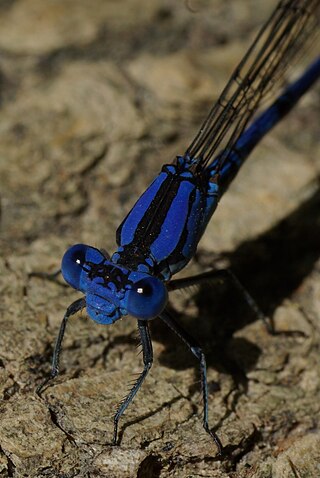
The springwater dancer is a damselfly of the family Coenagrionidae.

Aphylla is a widespread Neotropical genus of dragonflies of the Gomphidae family. They are commonly known as the greater forceptails because of their forceps-like cerci.
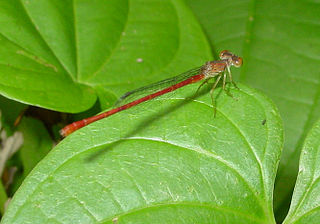
Telebasis is a genus of damselflies in the family Coenagrionidae. The genus occurs in the Neotropics. Most of the species are red with a few blue species in South America.

Micrathyria is a Neotropical genus of dragonflies. They have bright green eyes and white faces. Most species have a markedly striped thorax. They are commonly known as Tropical Dashers.

Triacanthagyna is a genus of dragonflies in the family Aeshnidae. The species have large eyes and broad wings. The females have three prominent spines under the last abdominal segment which gives the genus its name. They are commonly known as three-spined darners.


